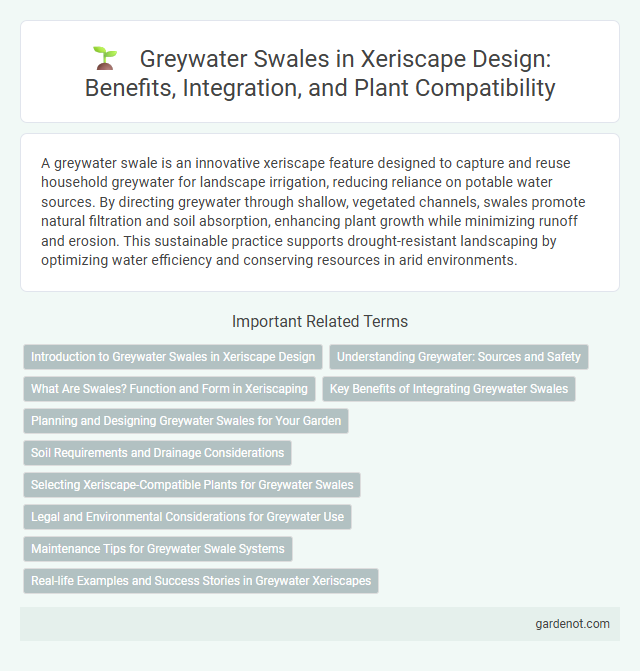A greywater swale is an innovative xeriscape feature designed to capture and reuse household greywater for landscape irrigation, reducing reliance on potable water sources. By directing greywater through shallow, vegetated channels, swales promote natural filtration and soil absorption, enhancing plant growth while minimizing runoff and erosion. This sustainable practice supports drought-resistant landscaping by optimizing water efficiency and conserving resources in arid environments.
Introduction to Greywater Swales in Xeriscape Design
Greywater swales, a critical element in xeriscape design, efficiently capture and filter household greywater for landscape irrigation. These shallow, vegetated channels reduce water runoff while promoting soil infiltration and plant health, optimizing water conservation in arid environments. Integration of greywater swales supports sustainable landscaping by recycling water and minimizing dependence on potable water resources.
Understanding Greywater: Sources and Safety
Greywater mainly originates from household activities such as laundry, dishwashing, and bathing, excluding water from toilets and kitchens due to high contamination levels. Understanding the composition of greywater is crucial for safe use in xeriscape irrigation, as it contains lower concentrations of harmful pathogens compared to blackwater but may include soaps, detergents, and food residues. Proper treatment and filtration systems ensure greywater is safe for soil absorption in swales, promoting sustainable water reuse while protecting plant health and preventing environmental contamination.
What Are Swales? Function and Form in Xeriscaping
Swales in xeriscaping are shallow, vegetated channels designed to capture and direct greywater runoff efficiently. They function by slowing water flow, allowing infiltration and filtering contaminants, which conserves water and supports plant health in drought-prone landscapes. Their form typically includes gently sloped banks lined with mulch or native plants, optimizing water absorption and soil stabilization.
Key Benefits of Integrating Greywater Swales
Greywater swales significantly reduce freshwater consumption by channeling household wastewater into landscape irrigation systems, promoting sustainable water management. They improve soil moisture retention and enhance plant health, supporting xeriscape principles by minimizing the need for supplemental irrigation. This integration also reduces stormwater runoff and lowers the risk of erosion, contributing to environmental conservation and cost savings in xeriscape garden maintenance.
Planning and Designing Greywater Swales for Your Garden
Effective planning and designing of greywater swales for xeriscape gardens involves assessing soil permeability and slope to ensure optimal water absorption and prevent erosion. Incorporating native drought-tolerant plants along the swale enhances filtration and water retention, promoting sustainable irrigation practices. Properly sized trenches and overflow outlets are crucial for managing greywater flow and protecting plant health while conserving water resources.
Soil Requirements and Drainage Considerations
Greywater swales require well-draining, porous soils such as sandy loam or loamy sand to prevent waterlogging and promote efficient infiltration. Incorporating organic matter improves soil structure while maintaining permeability essential for greywater absorption. Proper grading and gentle slopes facilitate consistent drainage, reducing the risk of surface runoff and soil erosion in xeriscape landscapes.
Selecting Xeriscape-Compatible Plants for Greywater Swales
Choosing xeriscape-compatible plants for greywater swales involves selecting species with high drought tolerance and the ability to thrive in nutrient-rich, moist soil conditions. Native grasses, sedges, and drought-resistant perennials like lavender and yarrow efficiently absorb greywater while reducing water usage. Properly selected plants enhance filtration, prevent soil erosion, and support sustainable water management in xeriscape landscapes.
Legal and Environmental Considerations for Greywater Use
Legal frameworks for greywater use in xeriscape designs vary by region, typically requiring compliance with local health and environmental regulations to prevent contamination and ensure safe irrigation practices. Environmental considerations emphasize the need for proper filtration and management of greywater swales to protect soil quality and prevent the proliferation of pathogens or toxic substances. Adhering to these legal and environmental standards supports sustainable water reuse while minimizing risks to public health and ecosystems.
Maintenance Tips for Greywater Swale Systems
Regular inspection and debris removal from greywater swale systems ensure efficient water flow and prevent blockages. Maintaining appropriate vegetation like drought-tolerant plants helps absorb excess greywater and reduces erosion. Periodic soil testing and adjusting mulch layers enhance filtration and promote healthy microbial activity, optimizing system performance.
Real-life Examples and Success Stories in Greywater Xeriscapes
Greywater swales have transformed water management in xeriscape gardens, such as the award-winning project in Tucson, Arizona, where reclaimed household water irrigates native plants, reducing potable water use by 50%. In Santa Fe, New Mexico, a residential xeriscape with integrated greywater swales demonstrated a 40% increase in plant survival rates during drought conditions, showcasing efficient water recycling. These real-life implementations highlight the environmental and economic benefits of greywater swales in sustainable landscaping.
Greywater swale Infographic

 gardenot.com
gardenot.com